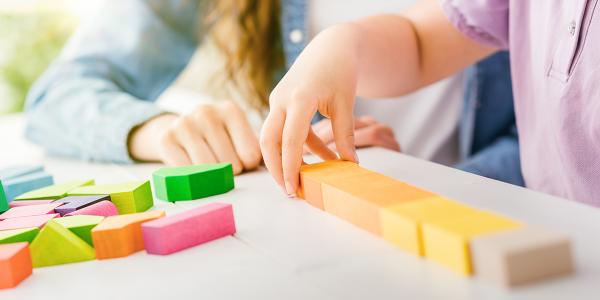Message in a Backpack: Helping Your Preschool Child with Computational Thinking

You are here
Encouraging “computational thinking” may sound intimidating, but it doesn’t have to be. It’s simpler than you think! Some researchers talk about it as learning to think like a computer scientist. But computational thinking doesn’t require using a computer. Children—including preschoolers—can learn how to use computational thinking to solve everyday problems.
Use the following tips to build on your preschooler’s math skills—including counting, pattern recognition, and sequencing to solve problems—to support computational thinking.
1. Play fun sequencing activities.
Pointing out the steps needed to complete a task can help children understand order and why it matters. Create cards for everyday tasks, like packing your lunch or feeding your pet. Discuss what happens when you mix up the steps and how to put the steps in the right order.
2. Explore patterns to find and fix mistakes.
Preschoolers enjoy exploring patterns around them. They can also show what they know by “debugging” mistakes they find in patterns. For example, you can create a set of colorful caterpillars out of clay, alternating the colors to form a pattern. Make some silly mistakes in the pattern, and encourage your child to check the pattern and to take pride in explaining to you what the problem is. Work together to come up with ways to fix it!
3. Make big problems more manageable.
Small problems for adults can seem like big ones for young children. Help your child make big jobs more manageable by breaking them into smaller jobs and making a plan. For example, packing a picnic lunch can seem like a big task, but not if you work together. With real or pretend food, determine together how many jobs there are to do. Then give each helper a job. Perhaps one helper counts and packs pretzels, another counts fruit, and another counts the dessert. When you break down the problem, it is much easier to solve!
Using these strategies with young children fosters early math skills that support computational thinking development. You can encourage your child by making time for or incorporating activities like these in everyday routines and by helping them think through the steps for solving problems and trying new things. You can also try GBH’s resources, which provide free, at-home learning activities that support computational thinking. Learn more at www.ahaisland.org.
This material is based upon work supported by the National Science Foundation under Grant No. Science Foundation (DRL-1612642). Any opinions, findings, and conclusions or recommendations expressed in this material are those of the author(s) and do not necessarily reflect the views of the National Science Foundation.
Heather Lavigne is a senior research scientist at Education Development Center in Waltham, Massachusetts.
Jillian Orr, EdM, GBH executive producer, focuses on participatory design with learning scientists, parents, teachers, and children to help build the research base for early learning with technology.
Marisa Wolsky is an executive producer and the director of children’s STEM media at GBH in Boston, Massachusetts.